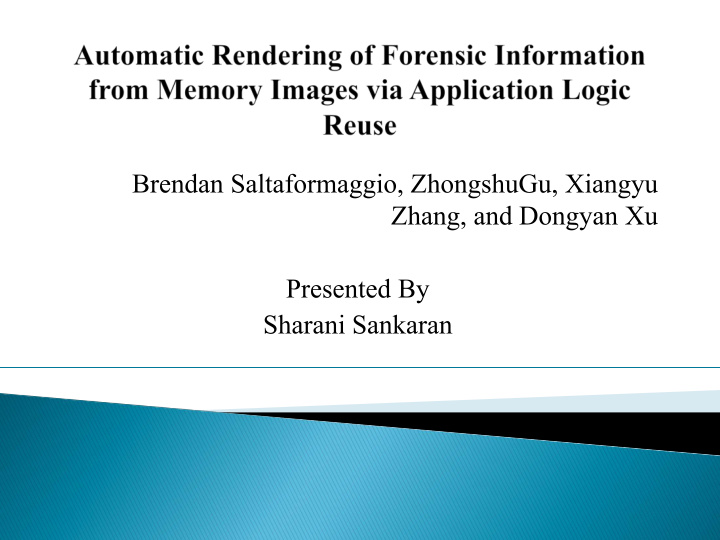



Brendan Saltaformaggio, ZhongshuGu, Xiangyu Zhang, and Dongyan Xu Presented By Sharani Sankaran
! Digital investigation based on analysis of non-volatile storage . ! Loss of live evidence stored in system RAM ! Information stored in RAM: executing processes open network connections volatile IPC data OS and application data structure
! It mainly capture an image of the suspect machine's volatile memory. ! The hardware and software based memory acquisition tools that are minimally invasive. ! It analyses the resulting memory image using memory analysis tools. ! The main aim is to recreate the system's previously observable state based on the memory image.
Signature based Scanning: ! The data structure signature is mainly derived by analyzing program binaries. ! The signature is used to scan memory images and identify the instances of data structures. ! It also present contents of identified instances to forensic investigators as potential evidence.
! It mainly finds raw data structure instances in memory image. ! Thus understanding the content of these data structures is extremely difficult or impossible.
• Application that defined the data structure contains printing/ rendering logic for it too. • Let’s call this function as P • The P function should take asinput the raw in memory data structure format it or process it to a human readable understandable PDF file
! DSCRETE reuse P to build reusing the existing data structure interpretation and binary a scanner+renderer tool. ! Invalid input will mainly crash the function P.
! The investigators recover the binary from the suspects computer . ! DSCRETE then builds a scanner+renderer tool in 2 steps. ! Thus the tool can be reused in all future investigations of that application
! It mainly execute the binary from the suspect’s computer . ! The slicing techniques find printing/rendering component. ! Select all the output functions that emit evidence. ! DSCRETE saves a memory snapshot during output function
! DSCRETE finds candidates for the entry point. ! Candidates must take a heap pointer as input. ! All these selected output/rendering functions must depend on it. ! It mainly uses the technique of Cross state execution to find the correct candidates.
! A correct candidate will output the PDF. ! It mainly presents each offset in suspect’s memory image to P and reports natural application output as evidence. ! This tool can be used in all future investigations.
! This has identified the main problem content Reverse Engineering problem in forensics. ! DSCRETE leverages binary logic reuse toautomatically locate data structures in memory images and reverse engineer content ! They are highly effective in recovering many forms of digital evidence
DSCRETE:(Automa/c(Rendering(of( Forensic(Informa/on(from(Memory( Images(via(Applica/on(Logic(Reuse.( ( Brendan(Saltaformaggio,(Zhongshu(Gu,(Xiangyu( Zhang,(and(Dongyan(Xu.(In(UsenixSecurity'14(
Paper(Discussion( Zhenyu(Ning( • CSC(6991(–(Advanced(Computer(System(Security( • In(contrast(with(the(stateSofStheSart(memory(forensics,(this(paper(presents(a(new(approach(to(achieve(memory( • forensics(without(reverse(engineering.(The(most(amazing(part(of(the(new(system,(DSCRETE,(is(that(it(output(the( display(of(the(target(data(structure(instead(of(just(raw(bytes(of(it.( To(achieve(this,(DSCRETE(try(to(run(the(target(binary(applica/on(in(the(same(environment(with(the(target(machine( • at(the(very(beginning(and(generate(a(memory(image,(together(with(an(instruc/on(record,(aWer(crea/ng(enough( target(data(structure(and(outpuXng(the(data(structure.(Then(through(some(sta/c(analysis(mechanism,(it(found( some(candidates(of(closure(points,(which(may(be(the(beginning(of(edi/ng(a(target(data(structure.(AWer(that,(the( binary(applica/on(is(reSexecuted.(When(the(execu/on(reaches(a(candidate,(a(sub(process(is(forked(and(pointer(to( the(target(data(structure(is(then(modified(to(point(to(some(old(data(which(is(mapped(from(the(memory(image( generated(in(the(first(execu/on.(With(the(result(of(execu/on(aWer(modify(the(pointer,(DSCRETE(then(briefly(judge( whether(a(candidate(is(a(real(closure(points.(AWer(it(gets(some(real(closure(points,(the(binary(applica/on(is( executed(for(the(third(/me(in(which(closure(points(and(sub(processes(are(used(to(find(all(poten/al(target(data( structures(in(the(memory(dump(and(also(show(the(display(of(the(data(structure(directly(to(inves/gator.( The(evalua/on(shows(that(DSCRETE(can(show(images,(pdfs,(files(and(some(other(complex(data(structures( • effec/vely,(but(has(a(bad(performance(when(facing(some(trivial(data(structure.(It(is(a(pity(that(DSCRETE(is(not( applicable(to(applica/ons(wri^en(in(interpreted(language(like(Java.(But(no/ce(that(we(can(reverse(Java(applica/on( much(easily(than(applica/on(wri^en(in(other(language.(If(mechanism(of(DSCRETE(can(be(used(to(Java(by(leverage( reverse(engineering,(I(guess(it(is(also(a(good(way(to(analysis(memory(in(Android(applica/on.(
Paper(Discussion( Lucas(Copi( • CSC(6991( • 14(October(2015( • Memory(Forensics( • The(paper( DSCRETE:(Automa/c(Rendering(of(Forensic(Informa/on(from(Memory(Images(via( • Applica/on(Logic(Reuse (discusses(a(new(method(for(forensically(retrieving(files(from(a(from(a( systems’(memory(image(using(DSCRETE.(Tradi/onal(forensics(u/lizes(signature(based(scanning(to( uncover(data(structures(in(memory.(However,(many(data(objects(in(memory(include(applica/on( specific(encoding,(making(it(difficult(for(inves/gators(to(render(the(data(in(a(meaningful(way.(The( DSCRETE(system(both(interprets(and(renders(data(structures(found(in(memory(to(present(the(data( in(a(human(readable(format.( DSCRETE(is(based(on(the(assump/on(that(data(structures(are(stored(with(rendering(logic(in(the( • original(applica/on(binary.(This(assump/on(allows(DSCRETE(to(isolate(data(structure(prin/ng( func/onality(in(the(applica/on(binary.(This(process(requires(tracing(the(subject(applica/ons( dynamic(data(dependences(and(loca/ng(the(closure(point(for(the(rendering(func/on.(Once(the(data( structure(rendering(func/on(has(been(fully(iden/fied,(DSCRETE(can(build(a(scanning+rendering(tool( from(the(subject(binary.( DSCRETE(was(implemented(and(tested(against(a(Ubuntu(desktop(‘suspect’(machine.(In(the(case( • studies,(DSCRETE(performed(at(expecta/ons(as(was(able(to(uncover(and(render(valid(data(structure( instances(with(100%(accuracy(for(most(cases.(Addi/onally,(DSCRETE(was(able(to(represent(several( key(types(of(evidence(that(would(be(nearly(impossible(to(reconstruct(with(tradi/onal(memory( forensic(systems.(
Paper(Discussion( Hitakshi(Annayya( • In(old(days(memory(forensics(used(to(inves/ga/ng(by(signature(based(scanning(of(memory(images( • to(uncover(data(structure(SS(Reverse(Engineering.(The(disadvantage(of(this(method(is(not(be(able(to( interpret(the(content(of(data(structure(fields.(The(paper(presents(new(method(called(DSCRETE(data( structure(content(reverse(engineering(technique,(which(is(a(system(that(enables(automa/c( interpreta/on(and(rendering(of(inmemory(data(structure(contents.(DSCRETE(is(able(to(recover(a( variety(of(applica/on(data(—(e.g.,(images,(figures,(screenshots,(user(accounts,(and(forma^ed(files( and(messages(—(with(high(accuracy.( The(key(idea(behind(DSCRETE(is(to(iden/fy(and(reuse(such(interpreta/on(and(rendering(logic(in(a( • binary(program(without(source(code(to(create(a(“scanner+renderer”(tool.( Assump/ons(made(for(DSCRETE(workflow:(first(S(DSCRETEbased(memory(the(subject(binary(can(be( • executed.(Second(S(the(OS(kernel’s(paging(data(structures(in(the(subject(memory(image(are(intact.( Many(phases(completes(the(design(of(DSCRETES(Dynamic(data(dependency(tracing((a(data( dependence(graph(is(generated(using(the(trace(gathered(during(dynamic(instrumenta/on.),(next( iden/fying(func/onal(closure,(to(find(scanners(entry(point,(and(finally(memory(image(scanning.(
Reminders( • Next(class:(Android(Security( • Proposal(revision( • Paper(summary(is(required(when(presen/ng(
Recommend
More recommend